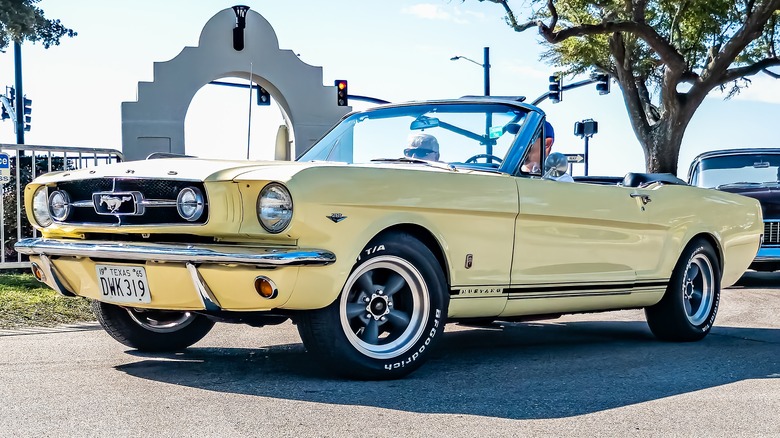
GT stands for "Grand Touring" or "Gran Turismo," the PlayStation gem that revolutionized racing games. Bam, done, we've cracked the case. Well, no, we can't leave it here, because telling you what words form the "GT" initialism doesn't foster deeper understanding.
Like many cool automotive terms, GT comes to us from Italy. A "Grand Tourer" or "Gran Turismo" model was a "do it all" kind of car, and the automotive moniker likely originated with the 1930 Alfa Romeo 6C 1750 Gran Turismo. Thank goodness
the Italian and English words happen to start with the same letter.
Even though the GT designation has become rather diluted, looking at the GT cars of the 1950s and '60s will give you a good idea of what the term used to mean. A "Grand Touring" car had to be sporty enough and comfortable enough to slot neatly between true luxury cars and all-out sports cars. Long distances could be swallowed up in relative comfort at high speeds, with sufficient handling prowess in reserve to manage turns when they arose.
By this definition, we can look at cars such as Ferrari's 250 GT series as perhaps the quintessential Grand Touring line, with such legends as the 250 GT SWB, Spyder California, and the most beautiful car of all time — don't argue, it is — the 250 GT Pinin Farina Coupe. Even some cars without the GT name clearly fit into this mould, such as the Jaguar E-Type, Mercedes 300SL, and Aston Martin DB5.
Read more: These Movies And TV Shows Have The Best Car Casting
GT Comes To America

Perhaps the most famous GT-badged car on this side of the pond is the Ford Mustang GT. Lee Iacocca, Ford's general manager and vice president in the 1960s, wanted a youth-oriented sporty car to boost the brand. Borrowing the Europey-sounding GT designation for the Mustang's high-performance V8 package helped it borrow coolness from the GT40. Since "GT" still carried weight and a specific definition, it helped cement the 'Stang as capable of thrilling performance and daily-usable comfort. Was the Mustang a GT in the traditional sense? If we qualify it by saying that it's closer to being a GT car than a standard Mustang, then sure.
What, then, of the Pontiac GTO and its faux racing branding? The "O" stands for "Omologato," or "Homologated" in English. Why not use GTH? Because that wouldn't have sounded European, nor would it have allowed for an egregiously fake comparison with a Ferrari 250 GTO in Car and Driver. The GTO was never intended to be "homologated," though it did enter FIA competition, something corporate parent GM didn't even want to do. Pontiac's designers named it "GTO" because it made the car sound fast. Indeed, it was fast, but it also championed the tradition of stretching the term "GT" until it broke.
Porsche's 911 GT cars are probably closest in spirit to the original GT designation with their comfy interiors and increased performance that still makes them dominant in GT racing. What's really fun is that the 911 GT3 Touring, when spelled out, is the Grand Touring 3 Touring, which is a bit like saying "ATM machine." The Nissan GT-R is also reasonably comfortable and daily drivable for its performance level, and Nissan added the "R" to point out that it also has "racing technology."
GT Means What You Want It To Mean, So Go Crazy And Apply It To Whatever

These days, "GT" can be put on anything, and usually it means the car is faster than a non-GT version, except when it isn't and the manufacturer doesn't even offer a non-GT variant. What makes the Porsche Carrera GT a GT car? That's not exactly a comfortable, opulent, long-distance, high-speed cruiser. Toyota's GR86 was designated the GT86 in Europe until 2022, when someone in the Toyota marketing department must have realized that a lengthy grand tour in a GT86 would be akin to punishment. And Hyundai saddling the Elantra with a GT suffix was the company writing checks the car couldn't cash. Car and Driver said that the Elantra GT's "base engine has feeble acceleration," hardly a GT trait.
You might also wonder why there are all these "GT" car races when so many of the cars in them clearly aren't "Grand Touring" cars, either. Well, keeping on the theme that GT is relative, GT race cars are at least based somewhat on real road cars, even if they are mostly supercars that also mostly aren't traditional Grand Tourers. They're more comfortable and less extreme than, say, open-wheel Formula 1 cars, at least.
All this leaves us with a "GT" designation that has become arbitrary. So, thanks, car manufacturers. Just chuck "GT" into the bin with other automotive designations that are meaningless now, such as "coupe" and "turbo." Perhaps most infuriatingly, smartphone/automaker Xiaomi has eclipsed even the Taycan Turbo's car-part-turned-marketing-term and named its electric motors "V6" and "V8."
Want more like this? Join the Jalopnik newsletter to get the latest auto news sent straight to your inbox...
Read the original article on Jalopnik.














